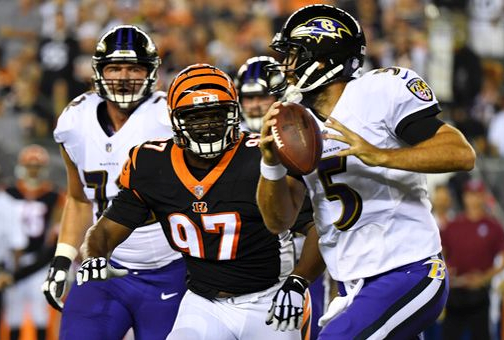Last night I was reading the story about Marshal Yanda losing 60 pounds in three months on ESPN.com. I then got curious as to how much the best guard in the NFL made over his lifetime with the Ravens and the answer was $70.24M over 13 seasons. Not bad scratch if you ask me. My mind wandered into the land of cap space and even for all of the team hatred that we have the Ravens are a masterfully run organizations. They arguably had the best GM, Ozzie Newsome, for a long time and they always seemed to make the cap work.
You often hear the news say “they will figure out a way to make it work in the cap” and that this is just a maneuvering game with the bean counters. I wanted to take a look to see how the Ravens managed a cornerstone player like Yanda versus how the Bengals handle one of their big names, Geno Atkins. The answer was telling and adds some credence to the Bengals being “cautiously thrifty” with their cash.
The numbers for Yanda can be found here. Basically when Yanda was signed to a big contract, like in 2011 when he got a 5 year/$32M contract the Ravens use the formula of small salary big bonus. Most fans know basically how the cap works. The salary counts against the cap on a per year basis and the signing bonus is prorated each year. A $10M bonus on a 5 year deal means a cap addition of $2M per season.
This is a standard thing across the NFL but the Ravens do a little extra. To create cap wiggle room they restructure bonus agreements based on need for cap in the following years. In 2012 Yanda was only getting a $700,000 salary fresh off that big deal but was supposed to get a $2M bonus so his cap hit would be $2.7M. Instead they “re-did” his deal and gave him a bonus of $3.8M because they had the room and needed it for next year; so they paid extra on their mortgage to make their next payment go down. $1.1M was saved for 2013 because they knew not only was Yanda’s salary going up but they could bank some cap room.
So how are the Bengals different? I took a look at Geno Atkins salary history found here. The Bengals are much more risk adverse and do not guarantee money to players. Sure they give a nice salary and an upfront signing bonus but you will also see money paid in roster bonuses and workout bonuses. That is so the Bengals can save money in case the player is injured, their is a contract dispute or the player is cut/traded. This also helps with accounting cash flow and allows the organization to hold on to their money a little longer.
So what does this mean for the cap? It means the Bengals sacrifice annual cap hits to keep their money. Not once did our highest paid player get a re-structured bonus which would create more cap room. The Bengals generally carry over cap room from the previous year. Instead of carry-over they could pay off the bonus money earlier and recoup those funds in actual cap space to either extend players or offer more guaranteed money in free agency. Ever ask why we don’t get the big names in Cincinnati? The reason is that players want that bigger bonus because it is guaranteed cash in the pocket. D.J. Reader’s contract is setup the exact same way as Atkins.

